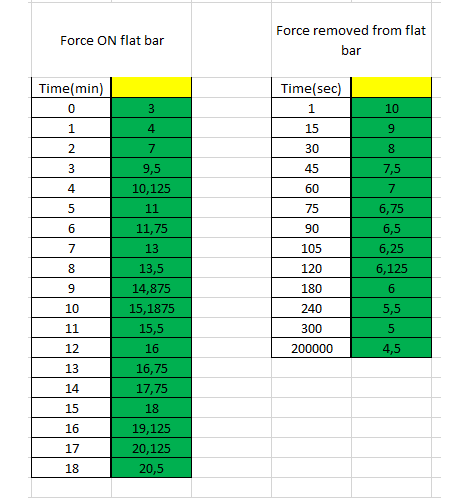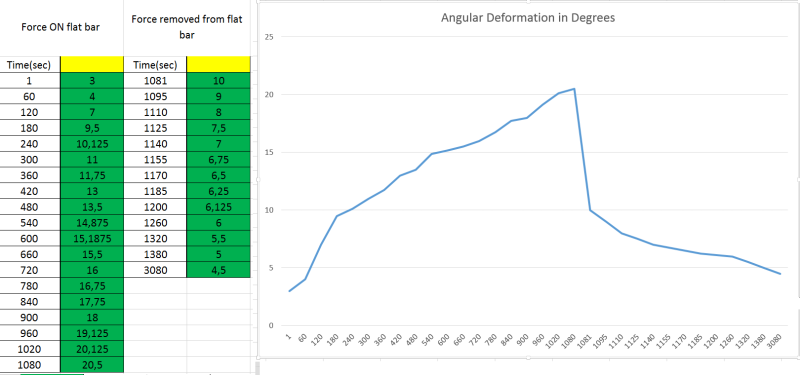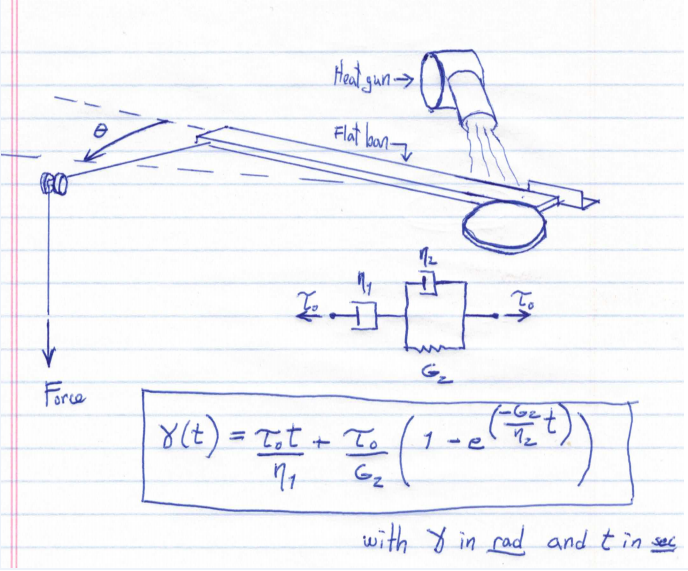Oueg18
Materials
- Dec 7, 2016
- 6
Hi,
I'm writing on this forum because I'm a bit at a lost with an analysis conducted with ANSYS workbench.
I've got creep response data and springback data: I used a test bench consisting of a constant weight pulling laterally a polypropylene flat bar (somewhat in the manner of a cantilever beam but pulled honrizontally)
SEE PICTURE in attachment Schematic and creep response equation.pdf
For the creep test: The heat gun warms the flat bar while the force is pulling on it: the magnitude of the angular deformation is measured as a function of time.
For the springback test: The heat from the heat gun and the force are both removed and the springback is measured as a function of time.
I've developped a creep equation for the creep test that also figures in the ATTACHMENT. Schematic and creep response equation.pdf
With matlab, I've fitted the equation and found the right parameters to fit my data.
I am now trying to model this experiment in ANSYS workbench. I've read a bunch on the subject but I'm having a hard time finding where to start and what should be included in my analysis.
From what I understand, I need to make a static structural analysis with the right temperature profile. That I can do. But so far, my analysis is carried out only in the elastic domain and this won't work since a permanent deformation remains in the flat bar, after the springback.
I know I must include PLASTICITY and/or VISCOELASTICITY in my material properties (like MISO and prony). But workbench asks for stress VS strain data and shear modulus VS time data. All I have is series of data of angular deformation (in rad) as a function of time (seconds).
Does the analysis must include both MISO (multilinear isotropic hardening) in the PLASTICITY TAB and viscoelastic shearing in the VISCOELASTICITY TAB? Is viscoelastic shearing sufficient alone? Because if both are needed I could go to my university and make some tensile test to obtain Stress VS strain data.
How can I use my results in Workbench? Can I include my creep response equation in Workbench?
How should I make an FEA analysis of this experiment using Ansys Workbench? I'm a bit familiar with command snippets in mechanical but I know next to nothing of mechanical APDL (Ansys classic)
Please help me, my director knows nothing in ANSYS and nobody at my university either
I'm writing on this forum because I'm a bit at a lost with an analysis conducted with ANSYS workbench.
I've got creep response data and springback data: I used a test bench consisting of a constant weight pulling laterally a polypropylene flat bar (somewhat in the manner of a cantilever beam but pulled honrizontally)
SEE PICTURE in attachment Schematic and creep response equation.pdf
For the creep test: The heat gun warms the flat bar while the force is pulling on it: the magnitude of the angular deformation is measured as a function of time.
For the springback test: The heat from the heat gun and the force are both removed and the springback is measured as a function of time.
I've developped a creep equation for the creep test that also figures in the ATTACHMENT. Schematic and creep response equation.pdf
With matlab, I've fitted the equation and found the right parameters to fit my data.
I am now trying to model this experiment in ANSYS workbench. I've read a bunch on the subject but I'm having a hard time finding where to start and what should be included in my analysis.
From what I understand, I need to make a static structural analysis with the right temperature profile. That I can do. But so far, my analysis is carried out only in the elastic domain and this won't work since a permanent deformation remains in the flat bar, after the springback.
I know I must include PLASTICITY and/or VISCOELASTICITY in my material properties (like MISO and prony). But workbench asks for stress VS strain data and shear modulus VS time data. All I have is series of data of angular deformation (in rad) as a function of time (seconds).
Does the analysis must include both MISO (multilinear isotropic hardening) in the PLASTICITY TAB and viscoelastic shearing in the VISCOELASTICITY TAB? Is viscoelastic shearing sufficient alone? Because if both are needed I could go to my university and make some tensile test to obtain Stress VS strain data.
How can I use my results in Workbench? Can I include my creep response equation in Workbench?
How should I make an FEA analysis of this experiment using Ansys Workbench? I'm a bit familiar with command snippets in mechanical but I know next to nothing of mechanical APDL (Ansys classic)
Please help me, my director knows nothing in ANSYS and nobody at my university either



